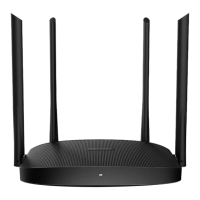It specifies various protocols adopted for wireless transmission.
2.4 GHz WiFi network supports 11b, 11g, 11b/g mixed and 11b/g/n
mixed modes.
11b/g/n: It indicates that all devices compliant with IEEE 802.11b or
IEEE 802.11g protocol, or work at 2.4 GHz with IEEE 802.11n protocol
can connect to the 5 GHz WiFi network of the router, therefore
enjoying a maximum transmission rate of 300 Mbps.
11b/g: It indicates that devices compliant with IEEE 802.11b or IEEE
802.11g protocol can connect to the 2.4 GHz WiFi network of the
router, enjoying a maximum transmission rate of 54 Mbps.
11b: It indicates that devices compliant with IEEE 802.11b protocol
can connect to the 2.4 GHz WiFi network of the router, enjoying a
maximum transmission rate of 11 Mbps.
11g: It indicates that devices compliant with IEEE 802.11g protocol
can connect to the 2.4 GHz WiFi network of the router, enjoying a
maximum transmission rate of 54 Mbps.
5 GHz WiFi network supports 11ac, 11a/n/ac mixed modes.
11a/n/ac: It indicates that all devices compliant with IEEE 802.11a or
IEEE 802.11ac protocol, or work at 5 GHz with IEEE 802.11n protocol
can connect to the 5 GHz WiFi network of the router, enjoying a
maximum transmission rate of 867 Mbps.
11ac: It indicates that devices complaint with IEEE 802.11ac protocol
can connect to the 5 GHz WiFi network of the router, enjoying a
maximum transmission rate of 867 Mbps.
It specifies the operating channel of a WiFi network.
By default, the wireless channel is Auto, which indicates that the
router selects a channel for the WiFi network automatically. You are
recommended to choose a channel with less interference for better
wireless transmission efficiency. You can use a third-party tool to scan
the WiFi signals nearby to understand the channel usage situations.

